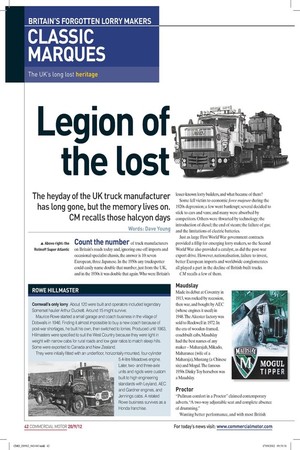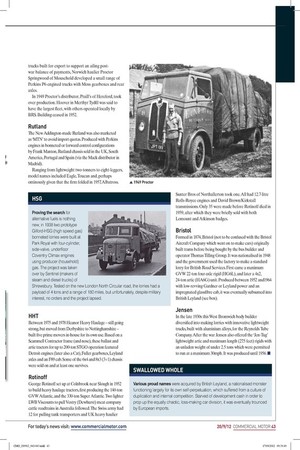Legion of the lost
Page 36

Page 37

If you've noticed an error in this article please click here to report it so we can fix it.
The heyday of the UK truck manufacturer has long gone, but the memory lives on. CM recalls those halcyon days
Words: Dave Young Count the number of truck manufacturers on Britain’s roads today and, ignoring one-off imports and occasional specialist chassis, the answer is 10: seven European, three Japanese. In the 1950s any truckspotter could easily name double that number, just from the UK, and in the 1930s it was double that again. Who were Britain’s
lesser-known lorry builders, and what became of them?
Some fell victim to economic force majeure during the 1920s depression; a few went bankrupt; several decided to stick to cars and vans; and many were absorbed by competitors. Others were thwarted by technology; the introduction of diesel; the end of steam; the failure of gas; and the limitations of electric batteries.
Just as large First World War government contracts provided a illip for emerging lorry makers, so the Second World War also provided a catalyst, as did the post-war export drive. However, nationalisation, failure to invest, better European imports and worldwide conglomerates all played a part in the decline of British-built trucks.
CM recalls a few of them.
Maudslay
Made its debut at Coventry in 1913, was rocked by recession, then war, and bought by AEC (whose engines it used) in 1948. The Alcester factory was sold to Rockwell in 1972. In the era of wooden-framed, coachbuilt cabs, Maudslay had the best names of any maker – Maharajah, Mikado, Maharanee (wife of a Maharaja), Mustang (a Chinese six) and Mogul. The famous 1950s Dinky Toy horsebox was a Maudslay.
Proctor
“Pullman comfort in a Proctor” claimed contemporary adverts. “A two-way adjustable seat and complete absence of drumming.” Wanting better performance, and with most British trucks built for export to support an ailing postwar balance of payments, Norwich haulier Proctor Springwood of Mousehold developed a small range of Perkins P6-engined trucks with Moss gearboxes and rear axles.
In 1949 Proctor’s distributor, Praill’s of Hereford, took over production. Hoover in Merthyr Tydil was said to have the largest leet, with others operated locally by BRS. Building ceased in 1952.
Rutland
The New Addington-made Rutland was also marketed as ‘MTN’ to avoid import quotas. Produced with Perkins engines in bonneted or forward control conigurations by Frank Manton, Rutland chassis sold in the UK, South America, Portugal and Spain (via the Mack distributor in Madrid).
Ranging from lightweight two-tonners to eight-leggers, model names included Eagle, Toucan and, perhaps ominously given that the irm folded in 1957, Albatross.
HHT
Between 1975 and 1978 Heanor Heavy Haulage – still going strong, but moved from Derbyshire to Nottinghamshire – built ive prime movers in-house for its own use. Based on a Scammell Contractor frame (and nose), these ballast and artic tractors for up to 200-ton STGO operation featured Detroit engines (later also a Cat), Fuller gearboxes, Leyland axles and an F89 cab. Some of the 6x4 and 8x3 (3+1) chassis were sold on and at least one survives.
Rotinoff
George Rotinoff set up at Colnbrook near Slough in 1952 to build heavy haulage tractors, irst producing the 140-ton GVW Atlantic, and the 330-ton Super Atlantic. Two lighter LWB Viscounts to pull Vestry (Dewhurst) meat company cattle roadtrains in Australia followed. The Swiss army had 12 for pulling tank transporters and UK heavy haulier Sunter Bros of Northallerton took one. All had 12.7-litre Rolls-Royce engines and David Brown/Kirkstall transmissions. Only 35 were made before Rotinoff died in 1959, after which they were briely sold with both Lomount and Atkinson badges.
Bristol
Formed in 1874, Bristol (not to be confused with the Bristol Aircraft Company which went on to make cars) originally built trams before being bought by the bus builder and operator Thomas Tilling Group. It was nationalised in 1948 and the government used the factory to make a standard lorry for British Road Services. First came a maximum GVW 22-ton four-axle rigid (HG6L), and later a 4x2, 24-ton artic (HA6G) unit. Produced between 1952 and1964 with low-revving Gardner or Leyland power and an impregnated glassibre cab, it was eventually subsumed into British Leyland (see box).
Jensen
In the late 1930s this West Bromwich body builder diversiied into making lorries with innovative lightweight trucks, built with aluminium alloys, for the Reynolds Tube Company. After the war Jensen also offered the ‘Jen-Tug’ lightweight artic and maximum length (27.5 feet) rigids with an unladen weight of under 2.5 tons which were permitted to run at a maximum 30mph. It was produced until 1956. n
ROWE HILLMASTER
Cornwall’s only lorry. About 120 were built and operators included legendary Somerset haulier Arthur Duckett. Around 15 might survive.
Maurice Rowe started a small garage and coach business in the village of Dobwalls in 1946. Finding it almost impossible to buy a new coach because of post-war shortages, he built his own, then switched to lorries. Produced until 1963, Hillmasters were specified to suit the West Country because they were light in weight with narrow cabs for rural roads and low gear ratios to match steep hills. Some were exported to Canada and New Zealand.
They were initially fitted with an underfloor, horizontally mounted, four-cylinder 5.4-litre Meadows engine. Later, twoand three-axle units and rigids were custom built to high engineering standards with Leyland, AEC and Gardner engines, and Jennings cabs. A related Rowe business survives as a Honda franchise.
HSG
Proving the search for alternative fuels is nothing new, in 1938 two prototype Gilford-HSG (high speed gas) bonneted lorries were built at Park Royal with four-cylinder, side-valve, underfloor Coventry Climax engines using producer (household) gas. The project was taken over by Sentinel (makers of steam and diesel trucks) of Shrewsbury. Tested on the new London North Circular road, the lorries had a payload of 4 tons and a range of 180 miles, but unfortunately, despite military interest, no orders and the project lapsed.
SWALLOWED WHOLE
Various proud names were acquired by British Leyland, a nationalised monster functioning largely for its own self-perpetuation, which suffered from a culture of duplication and internal competition. Starved of development cash in order to prop up the equally chaotic, loss-making car division, it was eventually trounced by European imports.













































